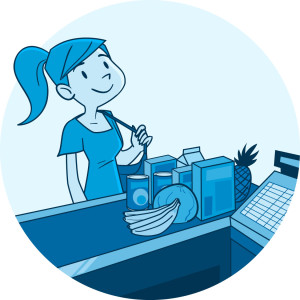Given the multiple ways consumers can get coupons – through events, in-store sampling, store affinity card programs, etc…we are always curious about what’s most effective for redemption.
We discussed it with Associate Professor Leonard Lee of the Columbia Business School, who, as it happens, did his dissertation on “Shopping Goals, Goal Concreteness, and Conditional Promotions.” The findings are fascinating.
With a test that compared shoppers outside the store to shoppers inside the store, he found significant differences. Outside, shoppers are less certain how much they plan to spend, the range is broader, the shopping list is less concrete, and even the way they describe what they are shopping for is more abstract: In front of the store, they say something general, like “I’m getting something for dinner.” Inside the store, they are more specific, i.e.; “I’m buying chicken.”
The research then went a step further to see if this ‘open-minded’ frame of mind outside the store correlates to promotional susceptibility. They tested the response to a coupon with a pre-set condition (buy xx amount, get xx amount off); then half of the consumers were sampled outside the store, and half inside. As predicted, “The flexibility of consumer’s shopping targets is higher before they enter the store, causing them to shape their behavior according to the conditions on the coupons. Once inside the store, consumers’ targets are more concrete and rigid, and the effectiveness of the conditional coupons is largely diminished.”
It makes sense. If you reach consumers with suggestions in the early phase of their shopping, you have a better chance of influencing that purchase. So the goal from the store management side is to continually ‘break-up’ that concrete mind-set. I’m reminded of an Acme in Maryland where I shop. It has aisles running every which-a-way — diagonally, horizontally and vertically, broken up by free-standing displays. Shoppers have to change direction frequently, and make decisions about how to approach a new section. That interrupts the natural tendency to zone out while going up and down in the same direction, just picking up the same few items.
What’s the takeaway for brand managers?
If you’re couponing, get out in front. Literally.
We’ve run very successful ‘out front’ coupon campaigns — some with radio stations, some with sampling teams. They’ve been incredibly effective – in one case lifting sales an insane 96% (yes, that’s IRI data).
The in-store programs have been run largely by the store sampling teams, with mixed results. We’ve run them with our own trained personnel, and seen strong results. When we’ve had to depend on the store for personnel, with less control of the message, we’ve seen predictably lower results in grocery, as measured by coupon redemption. In Walmart, which requires the use of an approved outside vendor, the well-trained staff was on message and the client was pleased by the outcome.
And what about the impact of digital options? We spoke last year about the many options that technology is developing. The biggest growth seems to be in store affinity programs, where consumers load their store affinity accounts with the coupons of their choice from a computer or mobile device. The coupons are credited at check out. This is obviously store-centric and expands the retailers’ command of the brand’s co-op budget.
Apps like “Endorse” seek to serve the brand no matter who the retailer is. Endorse members scan their receipts after purchase and if the items on the receipt match the offers of the week, they are credited on an Endorse account. The benefit to the consumer is that the coupon works with any store, so they’re not tied to an affinity program. The benefit to the brand is that they get demographic data back on who redeemed their offer, because Endorse knows the profiles of its members.
If we step back and apply the lessons of Dr. Lee’s research, the stores are doing it exactly wrong. Their websites encourage shoppers to make lists before shopping and pre-determine their desired coupons before they set foot in the store. This behavior is clearly reinforcing the ‘concrete’ thinking that is shown to depress spending. By how much? Another study shows a 2-to-1 ratio of shopper’s planned vs. unplanned purchases.
Clearly, the way to boost sales is to keep shoppers in an open, exploratory frame of mind, and support a sense of discovery. Predictability kills the impulse that increases purchase. In the email world, we call it “surprise and delight” – a strategy that keeps people opening their emails because they never know what wonderful things might be in there.
It’s a lesson worth taking from food marketing into other realms.

